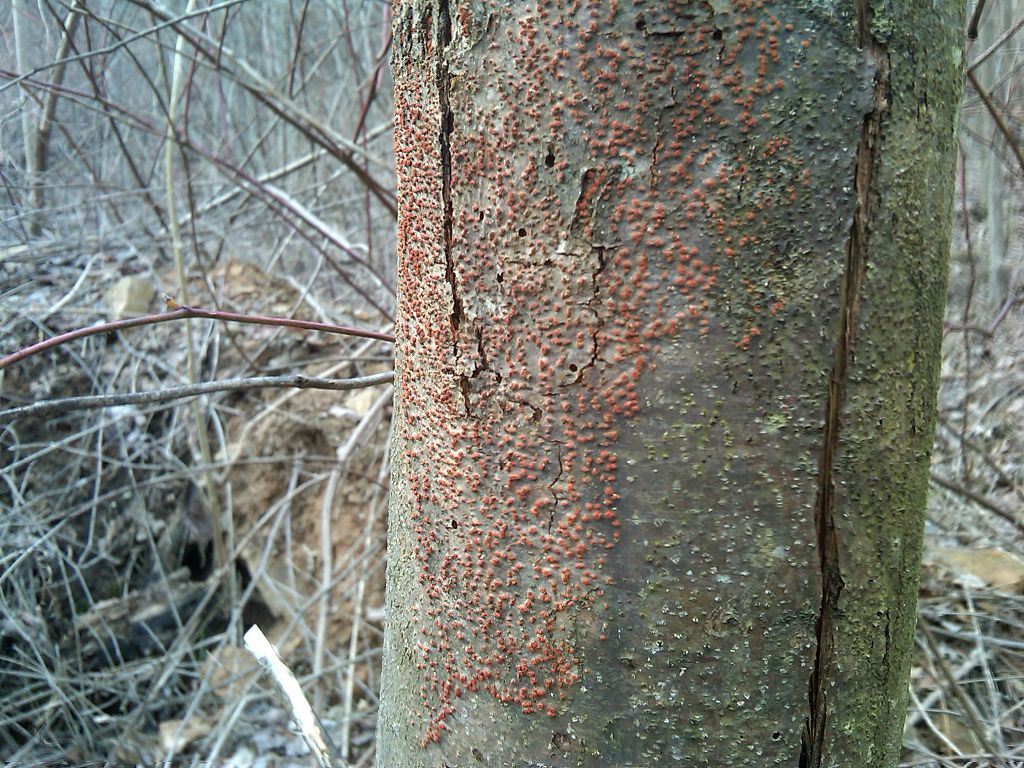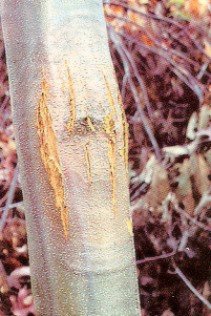Chestnut trees killed-Many immature saplings still remain but few mature trees exist. Struggling with blight American chestnut tree faces new disease identified by Erie County researchers.

Tree Diseases American Chestnut Blight Iron Tree Tree Knowledge Base
Like many other hyper-successful plant parasites Chestnut Blight is an invasive species.

. On Japanese chestnut trees imported at the end of the 1800s. Am Chestnut population decimated by Chestnut blight in early 1900s. Chestnut blight plant disease caused by the fungus Cryphonectria parasitica formerly known as Endothia parasitica.
The chestnut blight was accidentally introduced to North America around 1904 when Cryphonectria parasitica was introduced into the United States from East Asia from the introduction of the cultivation of Japanese chestnut trees into the United States for commercial purposes. Chestnut blight caused by fungus. Hypovirulence is a condition in which the blight fungus itself gets sick.
In 1900 the American chestnut was not only the dominant species of eastern hardwood forests in the US it was the most important tree commercially. Photo courtesy of Eric Evans of the Maine Chapter of The American Chestnut Foundation. The article below is a partial translation by Chengguo Wang of the Northwestern College of Forestry in Shaanxi.
Chestnut blight has ravaged populations of chestnut trees throughout the United States but it is most common in the East Coast. After an outbreak in Victoria in 2010 the Victorian government is working with the chestnut industry to eradicate chestnut blight. Chestnut blight a deadly fungal disease introduced to the United States from Asia in the early 1900s destroyed our chestnut forests and threatened the very existence of these important trees.
Robert Strasser Hood College240-285-8199 strasserhoodedu ANNAPOLIS MD April 5 2008 Chestnut blight Cryphonectria parasitica is a very lethal organism. The chestnut blight directly affects which structuretissue in the American chestnut tree. Which of the following is the defining characteristic of eudicots.
This parasitic fungus reached North America accidentally on chestnut trees shipped from Asia around the turn of the 20th century. Canker caused by a highly virulent form of Cryphonectria parasitica on American chestnut. However because these hypoviruses are limited to the cytoplasm they are only passed on.
It was first found in the chestnut trees on the grounds of the New York Zoological Garden the Bronx Zoo by Herman W. Link to an article that first describes the efficacy of the soil compress method in controlling chestnut blight cankers. Plant diseases can be caused by _____.
The original Chinese text was drawn up in 1979 for use within Chinese production areas. Note how the pathogen causes the collapse of stems along the outer surface of the stem. It is actually a canker disease caused by a fungus Cryphonectria parasitica formerly known as Endothia parasitica.
American chestnut trees and in most cases ultimately leads to tree death. Chestnut blight Cryphonectria parasitica is a notifiable plant disease in NSW. Erie has a Chestnut Street.
Canker disease branches die quickly infects branches diffuse tumorscankers blight resistance. The chestnut blight fungus was accidentally introduced into the US. In the decades following its initial detection it spread throughout the eastern US killing American chestnut as it progressed1.
Mixing trees American chestnut chinese version Techniques for restoring American chestnut tree. Parasitica is weakened preventing it from producing the devastating cankers that are a blight on American chestnuts. Cryphonectria parasitica-Introduced in 1904 from Asia on Asian chestnuts-1904 - 1940 4 billion Am.
In 1905 American mycolog. Discovered in chestnut blight cankers in Italy by Antonio Biraghi in 1953 this virus lives in the fungal cytoplasm. The significance of chestnut blight is tied to the species it decimated- the American chestnut Castanea dentata.
American chestnut was eliminated from eastern forests as a dominant species by chestnut blight Cryphonectria parasitica. Three North American tree species American chestnut Castanea dentata butternut Juglans cinerea and American elm Ulmus americana have been devastated by exotic fungal diseases over the last century. It infects various oaks and some other.
When infected with the hypovirus C. Cryphonectria Parasitica is a fungus which causes the condition known as Chestnut Blight. Merkel a forester at the zoo.
Ban Li - Chestnut Blight in China. What usually causes this weakening of the fungus is actually a virus which can be spread from one fungus to another. It was spread all over the range of our native chestnut trees by mail order as people bought chestnut trees from nurseries and was spread locally by every creature that walked over the cankers.
Chestnut Blight is a plant disease caused by a fungus which mostly affects the trunk and branches of host trees. Chestnut blight is a disease caused by the non-native fungus Cryphoectria parasitica which has killed most mature American chestnuts Castanea dentata throughout the trees rangeThe fungus was likely imported from Japan in the late 1800s and was first identified in the US. The pathogen that causes chestnut blight was first found on American chestnut in 1904 in New York Citys Zoological Park.
Accidentally imported from Asia the disease was first observed in 1904 in the New York Zoological Gardens. Once an important hardwood timber tree the American chestnut suffered a catastrophic population collapse due to the chestnut blight a disease caused by an Asian bark fungus Cryphonectria parasitica formerly Endothia parasitica. For more information on the blight as seen first-hand in China check out Ban Li which is Chinese for chestnut.
All of this began to change at or slightly before the turn of the century with the introduction of Cryphonectria parasitica the causal agent of chestnut blight. Infusion of wheat DNA. Since then tree breeders and researchers have worked to find blight-resistant varieties to bring American chestnuts back to our landscapes and forests.
If the canker girdles the stem then transport of nutrients is disrupted and all plant material beyond the canker dies back.

Chestnut Blight Facts And Information How To Prevent Chestnut Blight In Trees

New Genetically Engineered American Chestnut Will Help Restore The Decimated Iconic Tree The American Chestnut Foundation

Time To Scout For Chestnut Blight On European And Japanese Hybrid Cultivars Msu Extension

0 Comments